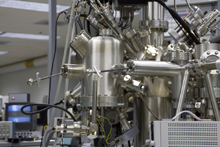
Onsite Research
Energy System Dynamics
|
|
| |
 |
|
|
Energy System Dynamics (ESD) is a focus area of the National Energy Technology Laboratory's Office of Research and Development (ORD). ORD also has focus areas in Computational and Basic Sciences, Geological and Environmental Sciences, and Materials Science and Engineering. Scientists and engineers in ORD conduct research at NETL's advanced research facilities in Morgantown, WV; Pittsburgh, PA; and Albany, OR, and at various offsite locations.
ESD conceives, analyzes, and develops pre-commercial energy technologies that can minimize the adverse environmental impacts of fossil fuel use and optimize the use of our domestic energy resources and infrastructure. ESD and our research partners investigate and test new energy system concepts and technologies over a range of time and length scales.
Core Competencies
To accomplish our mission, the ESD Focus Area has five core competencies addressing the need for clean-energy systems using domestic fuel sources. These competencies are:
- Thermal science
- Gas separation & purification
- Reactive flow & diagnostics
- Reactor design
- Dynamics and control
Capabilities
ESD's focus is on turbines, fuel cell systems, gasification, carbon dioxide (CO2) capture from power systems, oxy-fuel or chemical looping combustion, and sensor and control methods for all of these energy systems. ESD capabilities allow researchers to investigate:
- Technologies to capture CO2 during energy generation with minimal cost and efficiency impact
- Methods to use hydrogen combustion in turbines and engines without collateral pollutant emissions or efficiency penalties
- Performance of Department of Energy-developed fuel cells, to assist program planning
- Fundamental research in combustion sciences to provide the basis for a new generation of advanced fossil fuel conversion
- Sensors and control technology for advanced energy systems
- Fuel reforming and gas cleanup technologies that allow solid oxide fuel cells (SOFCs) to operate on existing infrastructure fuels, such as diesel fuel and coal syngas
Key Facilities
- Advanced Sensors Development Laboratory - Develops sensors with sophisticated hardware and software capabilities
- Catalyst Screening Unit - Advances concepts for fuel reforming and can easily be modified for various evaluations
- Co-gasification Kinetics Facilities - Studies biomass-coal kinetics
- Fuel Cell Test Facility - Evaluates fuel cell systems with up to 30 kW of power output
- Fuel Processing Unit - Tests 5-25 kW fuel processes. Mass spectrometry and gas chromatography are available for continuous analysis
- Hybrid Performance (HYPER) Laboratory - Explores the ability to control the flow of power from fuel cells and turbines in integrated systems
- Image Processing Laboratory - Analyzes particle sizes (1 µm to 20 mm) and shapes in solids, suspensions, and sprays using an image analysis sensor
- Multi-cell Array - Studies SOFCs operating on direct coal syngas using a fuel cell array and test skid that can be transported to gasifier sites
- High-Pressure Combustion Facility - Evaluates new high-pressure, high-temperature hydrogen turbine combustion concepts; includes a dynamic gas turbine test rig and an optically-accessible SimVal test rig
- Oxy-fuel Combustion Facility - Enables the study of fundamental combustion processes at the high steam and high-CO2 conditions found in oxy-fuel combustion systems
- Post-combustion CO2 Capture Facilities - Supports research in post-combustion CO2 capture with a laboratory-scale packed bed testing unit with a maximum testing temperature of 135 C and a maximum flow of 200 mL/min; a bench-scale packed bed reactor system; and a scrubbing unit that mimics a cyclic solvent capture process
- Pre-combustion CO2 Capture Facilities - Studies CO2 sorbents
- Small-scale Combustion Laboratory - Develops combustion control and diagnostic sensors
|
|
| |
 |
|
|
Recent Achievements
- ESD researchers developed and patented a low-cost, solid-state sorbent that can remove CO2 from power plant flue gas. The sorbent's low cost, availability, and simple preparation was recognized in 2009 with R&D Magazine's prestigious R&D 100 Award.
- Researchers have developed a new way to synthesize ionic liquids for CO2 capture using triazolium cations. The approach is flexible, which makes it a powerful tool for creating ionic liquids specifically tailored to particular applications.
- ESD researchers demonstrated that maintaining good fuel-to-metal oxide contact in chemical looping combustion can make solid-to-solid reactions possible at much lower temperatures than previously thought possible. The reaction produces a stream of sequestration-ready CO2 and thus avoids the high energy penalty typically associated with carbon capture.
- Integrated Pollutant Removal (IPR) Technology was developed by NETL to recover energy from oxy-combustion gases and concentrate the CO2 for sequestration. A patent application has been filed by NETL and the Jupiter Oxygen Corporation, which holds a limited license to use IPR technology in conjunction with their oxy-combustion technology. IPR technology is being marketed as a partner technology to oxy-fuel combustion; testing of both technologies continues at a JOC facility under an NETL contract.
- An ESD-developed catalyst exhibits stable, near-equilibrium performance while reforming either commercial diesel fuel or liquid biodiesel fuel, producing a hydrogen-rich synthesis gas that was used to power a fuel cell in the Fuel Cell Test Facility. The amount of rhodium per kW of electricity produced, a major factor in determining the total cost of a reformer, is significantly less with the NETL catalyst than with others evaluated for the same process.
|
|
| |
 |
|
|
Doing Business with Us
NETL, the research arm of the U.S. Department of Energy's Office of Fossil Energy, is advancing cost-effective and environmentally sound technologies to meet the nation's energy challenges. The Laboratory develops technologies and processes that answer pressing energy issues and provides our Nation's policymakers with the scientific information they need to set sound energy policy.
NETL welcomes opportunities to work with academia and the private sectors to develop and commercialize energy and environmental technologies. We frequently use Cooperative Research and Development Agreements (CRADAs) with the private sector. We also enter into license agreements for applying our inventions, and we make our laboratories and scientists in available for work-for- or work-with-others arrangements.
- Customer Service: 1-800-553-7681
- Point of contact: Martha Linhart, (412) 386-6540
|